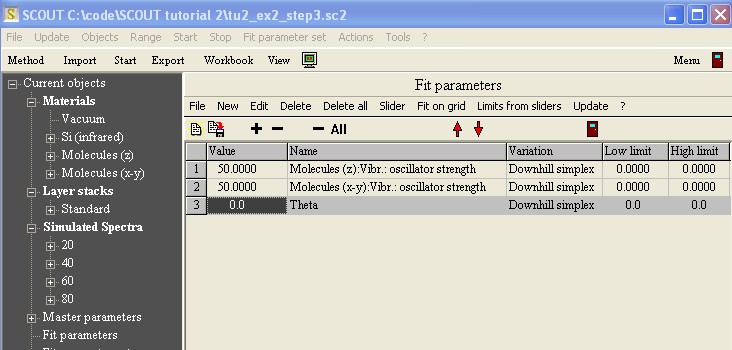Up to now the molecular layer has identical optical constants in all directions. It is still isotropic. Introducing molecular orientation with varying tilt angles affects the response both in z-direction and in the x-y-plane. Hence we have to modify two dielectric functions with one parameter. In SCOUT (version 2) you can do that defining the controlling parameter in the global list of master parameters.
Open this list with Object|Master parameters in the main window and create with '+' a new entry. Change the name to 'Theta' and the number of decimals to 1. Note that this time the name must not contain any spaces and mathematical symbols. Just use regular characters.
How do we have to modify the dielectric functions in the various directions with the tilt angle? As indicated in the following sketch the response of a molecule in the z-direction can be described using an oscillator the strength of which depends on tilt angle Θ.

The relation to be used for the oscillator strength in the z-direction is
![]()
In the x-y-plane the response is proportional to the squared of sin(Θ). Taking into account that on the average one half of the molecules' vibrations are in the z-x-plane and the other half in the z-y-plane one gets

To implement these relations we can proceed as follows. Open the list of fit parameters from the main window (Objects|fit parameters) and select the oscillator strengths of the vibrational modes in z-direction and in the x-y-plane as fit parameters. Select also the master parameter called 'Theta'. The list should look like the following now:

To enter the formulas that determine the relation between tilt angle and oscillator strength place the cursor to the column called 'Variation' in the first row. Press F4 and start to type in the following text:
80*COS(Theta/180*PI)
In the second row type in this:
80*SQRT(0.5*SQR(SIN(Theta/180*PI)))
Press Update and see that the oscillator strength in the z-direction is 80, that in the x-y-plane vanishes. The dialog is this now:

Set for the fit parameter Theta a low limit of 0 and a high limit of 90, as shown above. Then create a slider and move it. Watch how the oscillator strengths follow as slave parameters the changes of the master parameter Theta.
Note that the oscillator strengths in both directions are equal if the angle is roughly 54°. This is called the magic angle. If all molecules were tilted by this angle you could not see a difference to an isotropic, completely random orientation.
Besides the values of the slave parameters you can also watch how the spectra change with varying tilt angle. This instant update of all quantities with slider movements can instructively teach you where orientation effects show up in the spectra.
In case you had problems to follow the instructions above you can load the configuration tu2_ex2_step3.sc2 which contains the model developed up to now.